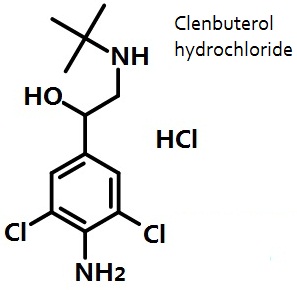| Identification | More | [Name]
Clenbuterol hydrochloride | [CAS]
21898-19-1 | [Synonyms]
4-AMINO-ALPHA-(T-BUTYLAMINOMETHYL)3,5-DICHLOROBENZYL ALCOHOL HCL
4-AMINO-ALPHA-[T-BUTYLAMINOMETHYL]-3,5-DICHLOROBENZYL ALCOHOL HYDROCHLORIDE
CLENBUTEROL HCL
CLENBUTEROL HYDROCHLORIDE
NAB 365CL
4-amino-alpha-((tert-butylamino)methyl)-3,5-dichlorobenzylalcoholhydrochlor
4-amino-alpha-((tert-butylamino)methyl)-3,5-dichloro-benzylalcohomonohydr
4-amino-alpha-((tert-butylamino)methyl)-3,5-dichlorobenzylalkohol-hydrochlor
clenbuterolclorhidrato
nab365
planiparthydrochloride
spiropent
ventipulmin
4-Amino-α-(t-butylaminomethyl)-3,5-dichlorobenzyl alcohol hydrochloride
Clenbuterol Hhydrochloride
Ventipulmi
Benzenemethanol, 4-amino-3,5-dichloro-.alpha.-(1,1-dimethylethyl)aminomethyl-, monohydrochloride
clenbutreol hydrochloride
1-(4-Amino-3,5-dichlorophenyl)-2-(tert-butylamino)ethanol hydrochloride
4-Amino-α-(tert-butylaminomethyl)-3,5-dichlorobenzyl alcohol monohydrochloride | [EINECS(EC#)]
244-643-7 | [Molecular Formula]
C12H19Cl3N2O | [MDL Number]
MFCD00083280 | [Molecular Weight]
313.65 | [MOL File]
21898-19-1.mol |
| Chemical Properties | Back Directory | [Appearance]
Colourless Microcyrstalline Powder | [Melting point ]
174-175.5°C | [Fp ]
9℃ | [storage temp. ]
2-8°C
| [solubility ]
Soluble in water and in ethanol (96 per cent), slightly soluble in acetone. | [form ]
neat | [color ]
White to off-white | [Usage]
Substituted phenylethanolamine with 2 sympathomimetic activity. Bronchodilator | [Merck ]
14,2347 | [InChIKey]
OPXKTCUYRHXSBK-UHFFFAOYSA-N | [CAS DataBase Reference]
21898-19-1(CAS DataBase Reference) |
| Safety Data | Back Directory | [Hazard Codes ]
T | [Risk Statements ]
R25:Toxic if swallowed. | [Safety Statements ]
S22:Do not breathe dust .
S36/37/39:Wear suitable protective clothing, gloves and eye/face protection .
S45:In case of accident or if you feel unwell, seek medical advice immediately (show label where possible) . | [RIDADR ]
UN 2811 6.1/PG 3
| [WGK Germany ]
3
| [RTECS ]
DN3180000
| [HazardClass ]
6.1(b) | [PackingGroup ]
III | [HS Code ]
29221990 | [Toxicity]
LD50 in mice, rats, guinea pigs (mg/kg): 176, 315, 67.1 orally; 27.6, 35.3, 12.6 i.v. (Ueberberg) |
| Hazard Information | Back Directory | [Chemical Properties]
Colourless Microcyrstalline Powder | [Definition]
Clenbuterol hydrochloride is a hydrochloride that is the monohydrochloride salt of clenbuterol.
| [Veterinary Drugs and Treatments]
Clenbuterol is approved for use in horses as a bronchodilator in the
management of airway obstruction, such as recurrent airway obstruction
(RAO; formerly COPD).
It has been used as a partitioning agent in food producing animals,
but its use for this purpose is banned in the USA as relay toxicity
in humans has been documented. |
| Questions And Answer | Back Directory | [Selective β2 adrenergic receptor agonist]
Clenbuterol-hydrochloride exhibits as white crystalline powder. Its chemical name is hydroxymethyl tert-butanol adrenaline or 2-[(tert-butylamino) methyl]-4-amino-3, 5-dichlorobenzene methoxide salt. It is a kind of potent, selectively β2 adrenergic receptor agonists and can be used for relaxing bronchial smooth muscle for the treatment of bronchial asthma, asthmatic bronchitis and bronchitis with emphysema.
The main component of "Shouroujing" is clenbuterol. Because of its certain effects on animals such as promoting the protein synthesis of muscle, promoting lipid decomposition and reducing fat accumulation, it can cause the relative increase of lean meat content of the animal and thus improving livestock quality. Owing to this property, we also referred it as "growth promoters" and "nutrition re-dispersing agent."
In the early 1960s, it was found that it can promote the animal growth; In the 1970s, the United States had introduced it into poultry production and it has become the world's most widely used β-stimulants. However, as the substance has a strong thermal stability and biochemical stability, after animal consumption, it is capable of forming residue in organs and tissues. Upon eating pork containing clenbuterol, people can get poisoning symptoms. Thus, many countries in the world had sooner or later banned the application of β-agonists in animal husbandry. Many countries have developed detection method for monitoring β-agonists residues and clenbuterol of the feed. In 1997, our government had also banned clenbuterol for being used as feed additives.
Precautions: a minority of patients may get adverse reactions such as mild heart palpitations, tremor, and dizziness with the symptoms gradually disappear in general after the medication. Patients of hyperthyroidism, tachycardia or hypertension should be taken with caution.
Preparation: ordinary tablets, aerosols, suppositories, films agent and patches.

The above information is edited by the Chemicalbook of Dai Xiongfeng.
| [Uses]
Clenbuterol hydrochloride can be used for the prevention and treatment of bronchial asthma, chronic bronchitis, emphysema-accompanied bronchial spasms caused by bronchitis.Clenbuterol hydrochloride is a kind of β2-adrenergic receptor agonists and can be used as bronchodilators.
| [Category toxic]
substances
| [Toxicity grading]
highly toxic
| [Acute toxicity]
intraperitoneal-mouse TDL0: 2 mg/kg
| [Flammability and hazard characteristics]
flammable with combustion cause its decomposition into toxic chloride and nitrogen oxide gases
| [Storage properties, warehouse]
cold, ventilated and dry; store it separately from food raw materials
| [Extinguishing media]
Water, carbon dioxide, dry, sandy soil. |
|
|